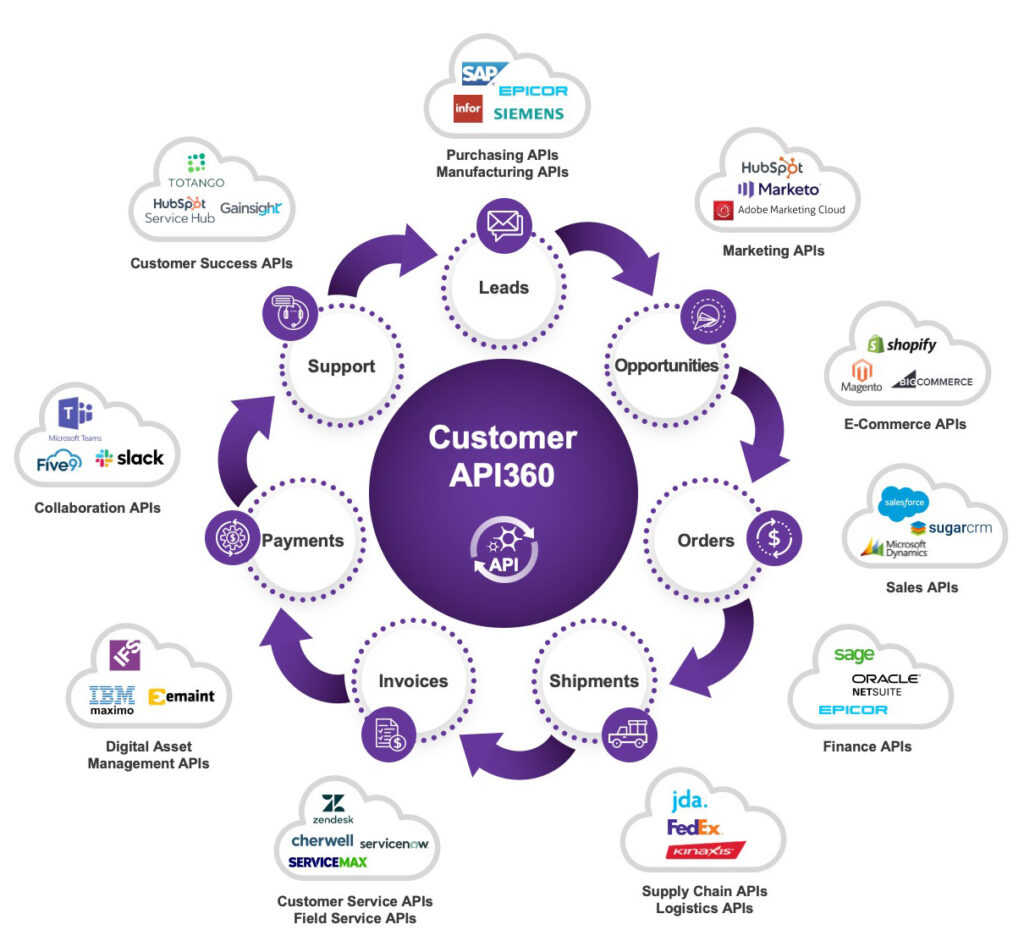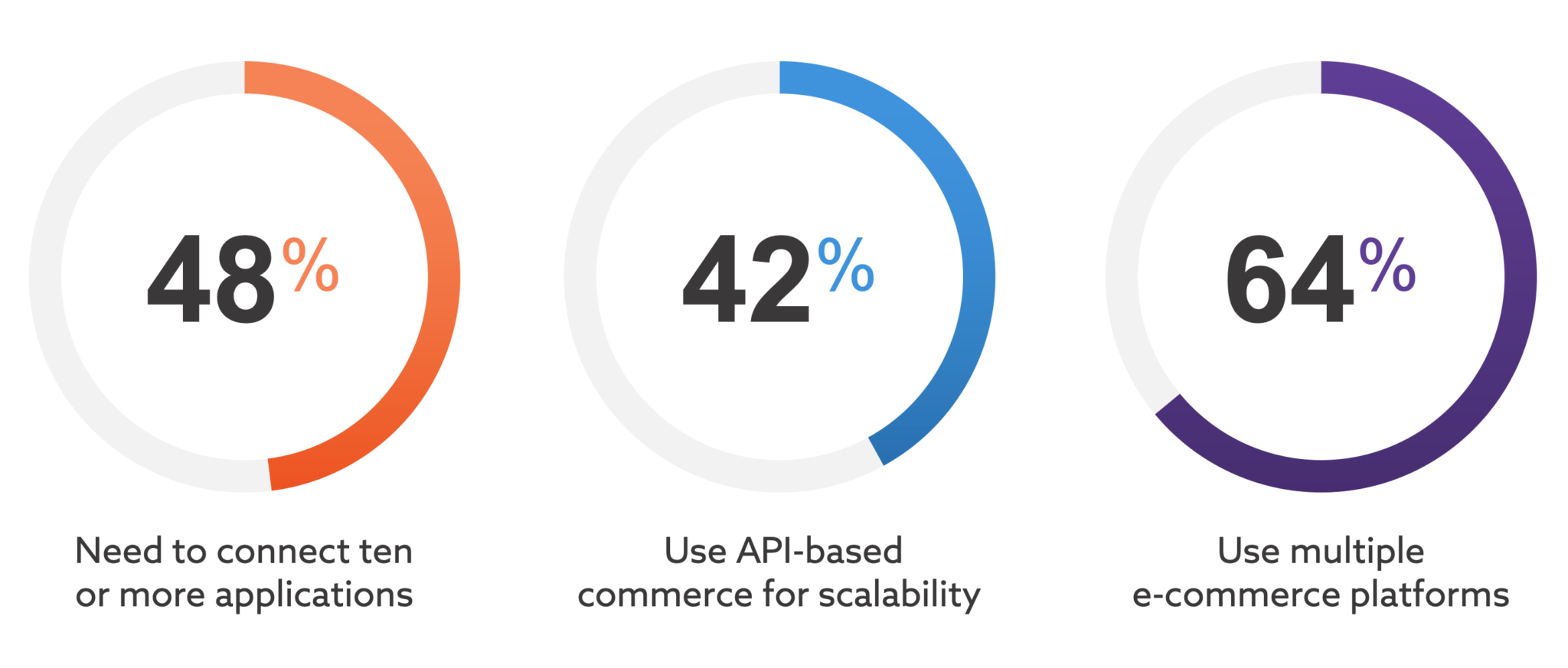By Carole Achramowicz, Senior Director of Product Marketing
Ecommerce Integration
The Key to Creating Exceptional Customer Experiences
A recent Jitterbit survey looked at the top investment drivers in ecommerce and found that ecommerce success often correlates with integrating a variety of complex systems and applications to get the most out of customer data.
But, before we dive too deep, first thing’s first…
What is Ecommerce Integration and Why Today’s Merchants Need It
So, what is ecommerce integration? At the most basic level, ecommerce integration connects the front end of an ecommerce site with back-end systems that handle functions such as accounting, logistics, warehouse management, shipping, customer service, and more. Integrating systems used across an ecommerce experience enables merchants to:
- Automate manual processes.There is a wealth of information across systems, from orders to marketing to purchasing to support. The problem is that this data resides across disconnected and siloed systems. Data is often pulled manually from one system and input into another. Automatically synchronizing the data in these disparate systems helps streamline processes, such as quote-to-cash, order fulfillment, and supply chain management. The result is increased productivity and a single source of truth for your data.
- Reduce data errors.Customer data lives in different applications, but that data is often the same — a mailing address, for example. Manually entering and re-entering data into other systems can lead to errors. If a business isn’t automating and synchronizing this data, there’s a potential a customer will be asked multiple times for the same piece of information, or worse yet, there are errors in the data. Integration ensures automatic data consistency across your disparate applications.
- Drive greater efficiencies.Integrations built with easy-to-use, low code, extensible integration tools help you scale so that once you have one or two integrations in place, new integrations can be added with ease.
The Business Impact of Poor [or no] Integration
Clint Nelms, vice president of professional services at Infinite Resource Solutions, has provided ecommerce integration services to a number of businesses, and he has previously offered his perspective in a Salesforce Ecommerce Integration Series webinar titled, “Ask an Expert: How to Scale Your Ecommerce Initiatives with Salesforce.”
In a recent conversation, Nelms laid out the issues that can arise if an organization doesn’t have proper ecommerce API integration in place. “Customer data lives in different silos,” he explained. “But that data is often the same — maybe a mailing address within three different systems. Suppose a business isn’t automating and synchronizing this data behind the scenes. In that case, there’s a potential a customer will be asked for that information multiple times, and there’s zero tolerance for that at the consumer level.”
Nelms says that making sure there is automatic data consistency behind the scenes is vital, and the idea that this level of synchronization should have ever been manual is misguided. “Especially in smaller organizations, for any business process that is manual and dependent on an IT person to make information available and flowing to the apps and systems that are in place, you have to ask, ‘What if they get another job, they are replaced by a new person, or are simply out sick on a given day?’” Consumers make buying decisions based on customer experience and lack of hassle. Companies must optimize the buying experience to thrive. With so many streamlined and easy-to-use buying experiences available in the market, any hint of inconvenience is likely to cause consumers to turn elsewhere.
A Customer API360 Approach
Delivering exceptional customer experiences benefits not only the consumer, but also the merchant in the form of return business and consumer loyalty. Jitterbit offers Customer API360 – an integration solution based on Jitterbit’s API integration platform (iPaaS platform) and the best practices of the thousands of integrations that Jitterbit customers and partners have implemented. It connects and automates disparate systems, automates critical business processes, and enables a 360-degree view of customers, partners, and products. The heart of Jitterbit’s ecommerce integration approach involves three basic components:
Application Connectors: These are out-of-the-box capabilities that provide pre-built and reusable connectivity to a specific endpoint, such as Salesforce or NetSuite. Connectors share data bidirectionally and provide a flattened interface to reduce the complexity of interacting directly with an endpoint’s API or data exchange protocols. They are used to take the guesswork out of vendor APIs for faster and easier mapping and integration design.
Integration Recipes: Recipes are single pre-built integration projects that move data in one direction between like objects across two applications or systems. For example, this could be Salesforce-Shopify integration, NetSuite-Amazon integration, or BigCommerce integration with an ERP to get the most out of that ecommerce platform.
Process Templates: These are groups of pre-built integration use cases that accelerate the execution of a specific business process using a number of objects across multiple applications or systems. Templates reduce time-to-deploy by up to 80% and can be self-implemented, delivered by Jitterbit Professional Services, or by an implementation partner for optimal ecommerce platform integration.
When it’s all put together, merchants create a 360-degree view of products, sales, and customers across all of their systems, which significantly streamlines processes and reduces errors and cost. This level of ecommerce integration software is becoming a must-have in today’s competitive landscape.

Common Ecommerce Integration Use Cases
Let’s get into some specific use cases to understand what successful ecommerce integration can look like:
- Order to fulfillment: To create a smooth purchasing experience, you need visibility into the end-to-end customer journey. Orders must be exported from sales systems and fed into distribution systems. Shipment information needs to be relayed to the customer to follow their purchase delivery, and inventory needs to be updated instantaneously. Building exceptional customer experiences depends on capturing, harnessing, and processing data and insights across this landscape of applications. Examples of Jitterbit solutions include NetSuite-Magento, NetSuite-BigCommerce, Epicor-BigCommerce, Epicor-Magento, Epicor-Shopify, and NetSuite-Shopify API integration.
- Opportunity to order: When sales opportunities close, orders need to be processed as efficiently and quickly as possible. Providing a seamless customer order experience requires integrating data and processes across your systems. When sales opportunities close in your CRM system, automatically creating sales orders in your ERP system helps reduce data entry errors and improve order accuracy. Examples of Jitterbit solutions include NetSuite-Microsoft Dynamics and Salesforce-NetSuite ecommerce integration.
In the end, if you’re using any combination of the apps and systems mentioned above (not to mention others that we haven’t yet mentioned), Jitterbit can help integrate them all for a true 360-degree customer experience that will turn clunky processes into a streamlined win-win situation for both you and your customers.
Here’s How to Get Started
We’ve said it before, but it’s worth reiterating: today’s merchants need to meet increasingly high customer expectations in order to remain competitive. In the past, modern API integration for ecommerce might have been nice to have, but today it’s increasingly a must-have. It’s vital to create a 360-degree view of the customer to create better user experiences and leverage the data that flows in and out of all of these individual systems. Simply put, those who do it smartly will thrive, while those who do not won’t last.
Here is a quick guide of resources that can help you get started today:
- Visit Jitterbit’s ecommerce page to learn more about what integration can do for your business
- Contact us for a complimentary ecommerce integration assessment
- Learn ecommerce integration best practices with our exclusive report, “Building a Connected Digital Commerce Experience”



